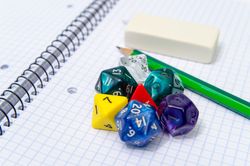
Whether they’re in elementary or high school, many children struggle with certain concepts in math. However, their reluctance is often rooted in a bit of boredom and discomfort. Like many skills, spending some time doing a few warm-up exercises can help make math class and homework a little easier. Below, learn a few activities that can reintroduce different math techniques until they become familiar again.
3 Ways to Warm Up for Math Class & Homework
1. Card Games
If you want a kinesthetic math warm-up, you can’t go wrong with card games. A popular one that’s easy to learn is Addition War. To begin, establish that when the court cards are present, the jacks are considered number 11, queens are 12, and kings are 13. With this in mind, split the deck evenly between you and your child. Then, at the same time, both of you will draw two cards from your piles and add the numbers together. The player with the highest total wins that round and collects all the cards. Continue until all the cards are played, and the winner is the one with them all. For older kids, try multiplying the numbers instead.
2. Dice Rolls
 Rolling dice is perfect for kinesthetic learners, and is a fun way to learn arithmetic. If you’re familiar with role-playing games, you can make this more interactive by crafting a story and setting up some obstacles. For example, you could tell your kid there’s a monster, and they’ll need to “attack” by rolling a certain number of points or higher. Then, have them roll however many dice they have and add everything together. If they’re older, you can use different dice types, each with different rules. For example, a six-sided die is for adding, while a four-sided die is for subtraction. If you have a twenty-sided die, that can be a multiplication modifier.
Rolling dice is perfect for kinesthetic learners, and is a fun way to learn arithmetic. If you’re familiar with role-playing games, you can make this more interactive by crafting a story and setting up some obstacles. For example, you could tell your kid there’s a monster, and they’ll need to “attack” by rolling a certain number of points or higher. Then, have them roll however many dice they have and add everything together. If they’re older, you can use different dice types, each with different rules. For example, a six-sided die is for adding, while a four-sided die is for subtraction. If you have a twenty-sided die, that can be a multiplication modifier.
3. Notice & Wonder
For kids who favor language arts, this exercise can help them bridge the gap to their math class. You start by presenting your child with an image, graph, or chart. It can be anything from a colorful graphic of geometric shapes to a photo of buttons in various jars. With this in front of them, have them write out everything they notice and any questions they have about it. There are no right or wrong answers. The goal is to have them observe the situation and start making connections. By encouraging them to voice their observations, they’ll be more comfortable working with the material.
To further improve your child’s skills in math class, contact Mathnasium in South Windsor, CT. They are known for their individual and customized instruction, and their lesson plans are designed to create a solid foundation for every student, based on their current abilities. You can learn more about the Mathnasium Method™ online. If you have any questions, don’t hesitate to call them at (860) 432-7794.
About the Business
Have a question? Ask the experts!
Send your question

